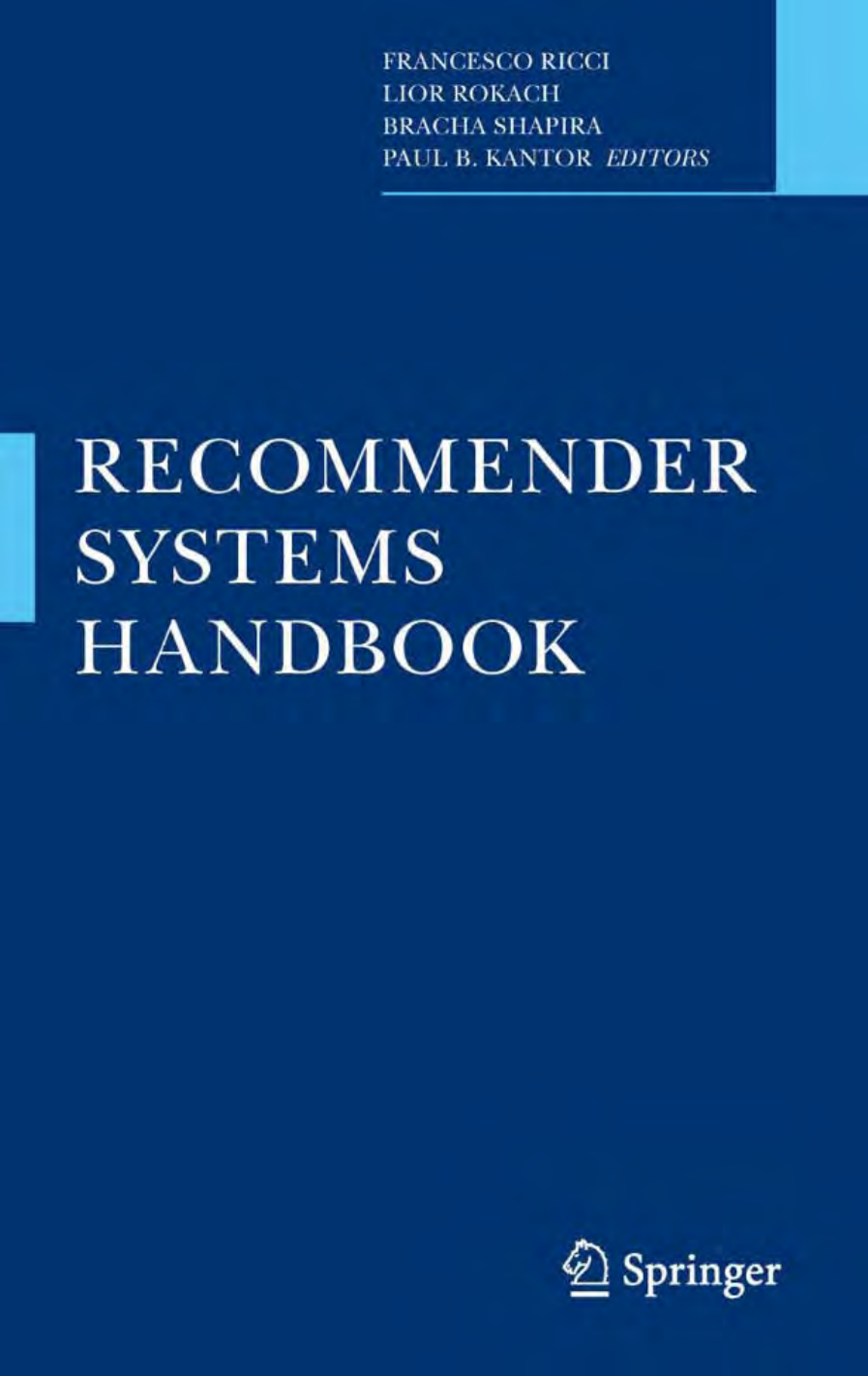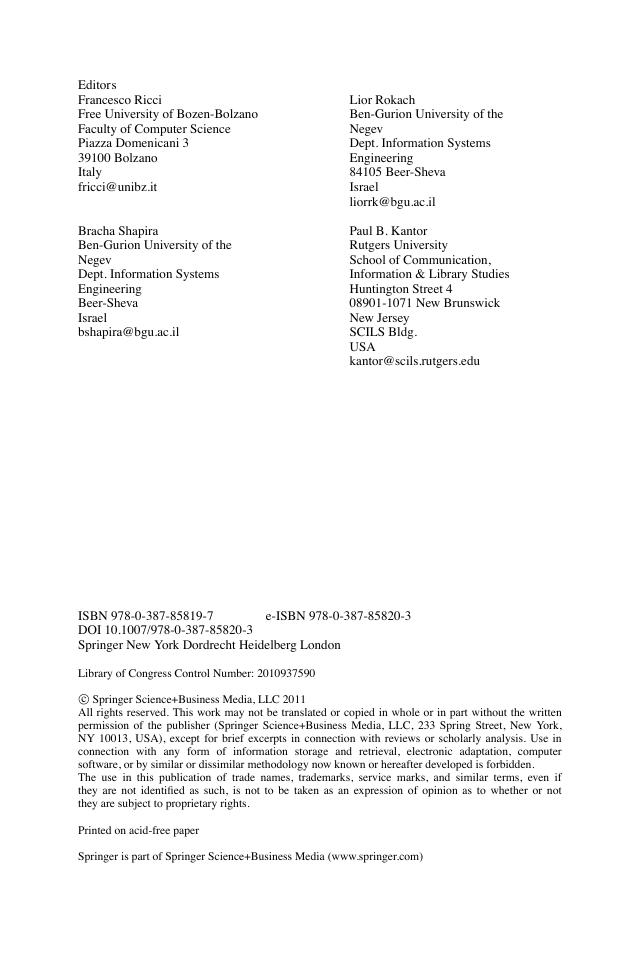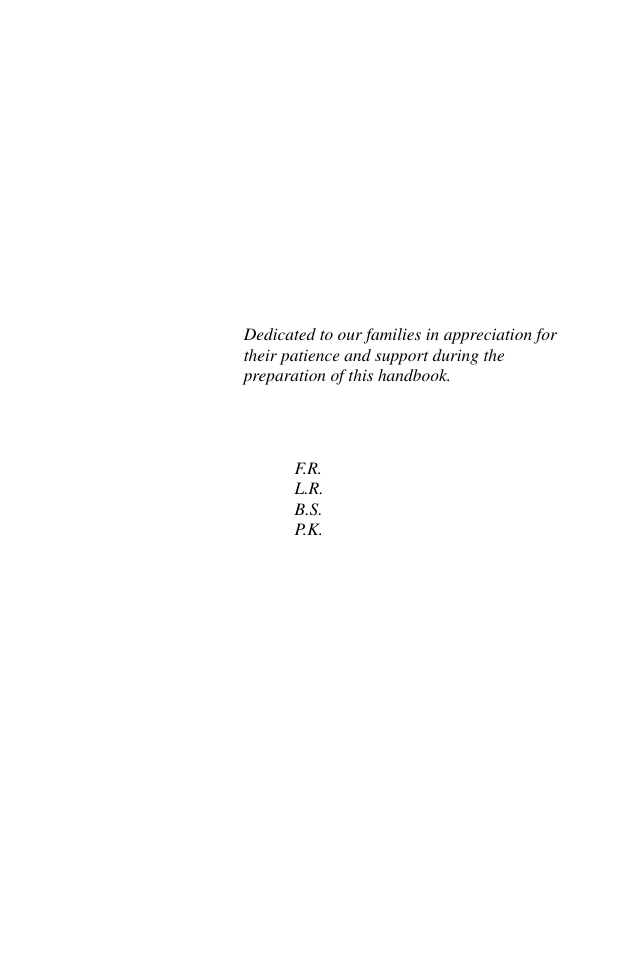Preface
Contents
Chapter 1 Introduction to Recommender Systems
Handbook
1.1 Introduction
1.2 Recommender Systems Function
1.3 Data and Knowledge Sources
1.4 Recommendation Techniques
1.5 Application and Evaluation
1.6 Recommender Systems and Human Computer Interaction
1.6.1 Trust, Explanations and Persuasiveness
1.6.2 Conversational Systems
1.6.3 Visualization
1.7 Recommender Systems as a Multi-Disciplinary Field
1.8 Emerging Topics and Challenges
1.8.1 Emerging Topics Discussed in the Handbook
1.8.2 Challenges
References
Part I
Basic Techniques
Chapter 2 Data Mining Methods for Recommender
Systems
2.1 Introduction
2.2 Data Preprocessing
2.2.1 Similarity Measures
2.2.2 Sampling
2.2.3 Reducing Dimensionality
2.2.3.1 Principal Component Analysis
2.2.3.2 Singular Value Decomposition
2.2.4 Denoising
2.3 Classification
2.3.1 Nearest Neighbors
2.3.2 Decision Trees
2.3.3 Ruled-based Classifiers
2.3.4 Bayesian Classifiers
2.3.5 Artificial Neural Networks
2.3.6 Support Vector Machines
2.3.7 Ensembles of Classifiers
2.3.8 Evaluating Classifiers
2.4 Cluster Analysis
2.4.1 k-Means
2.4.2 Alternatives to k-means
2.5 Association Rule Mining
2.6 Conclusions
Acknowledgments
References
Chapter 3 Content-based Recommender Systems: State of
the Art and Trends
3.1 Introduction
3.2 Basics of Content-based Recommender Systems
3.2.1 A High Level Architecture of Content-based Systems
3.2.2 Advantages and Drawbacks of Content-based Filtering
3.3 State of the Art of Content-based Recommender Systems
3.3.1 Item Representation
3.3.1.1 Keyword-based Vector Space Model
3.3.1.2 Review of Keyword-based Systems
3.3.1.3 Semantic Analysis by using Ontologies
3.3.1.4 Semantic Analysis by using Encyclopedic Knowledge Sources
3.3.2 Methods for Learning User Profiles
3.3.2.1 Probabilistic Methods and Na¨ıve Bayes
3.3.2.2 Relevance Feedback and Rocchio’s Algorithm
3.3.2.3 Other Methods
3.4 Trends and Future Research
3.4.1 The Role of User Generated Content in the Recommendation
Process
3.4.1.1 Social Tagging Recommender Systems
3.4.2 Beyond Over-specializion: Serendipity
3.5 Conclusions
References
Chapter 4 A Comprehensive Survey of
Neighborhood-based Recommendation Methods
4.1 Introduction
4.1.1 Formal Definition of the Problem
4.1.2 Overview of Recommendation Approaches
4.1.2.1 Content-based approaches
4.1.2.2 Collaborative filtering approaches
4.1.3 Advantages of Neighborhood Approaches
4.1.4 Objectives and Outline
4.2 Neighborhood-based Recommendation
4.2.1 User-based Rating Prediction
4.2.2 User-based Classification
4.2.3 Regression VS Classification
4.2.4 Item-based Recommendation
4.2.5 User-based VS Item-based Recommendation
4.3 Components of Neighborhood Methods
4.3.1 Rating Normalization
4.3.1.1 Mean-centering
4.3.1.2 Z-score normalization
4.3.1.3 Choosing a normalization scheme
4.3.2 Similarity Weight Computation
4.3.2.1 Correlation-based similarity
4.3.2.2 Other similarity measures
4.3.2.3 Accounting for significance
4.3.2.4 Accounting for variance
4.3.3 Neighborhood Selection
4.3.3.1 Pre-filtering of neighbors
4.3.3.2 Neighbors in the predictions
4.4 Advanced Techniques
4.4.1 Dimensionality Reduction Methods
4.4.1.1 Decomposing the rating matrix
4.4.1.2 Decomposing the similarity matrix
4.4.2 Graph-based Methods
4.4.2.1 Path-based similarity
4.4.2.2 Random walk similarity
4.5 Conclusion
References
Chapter 5
Advances in Collaborative Filtering
5.1 Introduction
5.2 Preliminaries
5.2.1 Baseline predictors
5.2.2 The Netflix data
5.2.3 Implicit feedback
5.3 Matrix factorization models
5.3.1 SVD
5.3.2 SVD++
5.3.3 Time-aware factor model
5.3.3.1 Time changing baseline predictors
5.3.3.2 Time changing factor model
5.3.4 Comparison
5.3.4.1 Predicting future days
5.3.5 Summary
5.4 Neighborhood models
5.4.1 Similarity measures
5.4.2 Similarity-based interpolation
5.4.3 Jointly derived interpolation weights
5.4.3.1 Formal model
5.4.3.2 Computational issues
5.4.4 Summary
5.5 Enriching neighborhood models
5.5.1 A global neighborhood model
5.5.1.1 Building the model
5.5.1.2 Parameter Estimation
5.5.1.3 Comparison of accuracy
5.5.2 A factorized neighborhood model
5.5.2.1 Factoring item-item relationships
5.5.2.2 A user-user model
5.5.3 Temporal dynamics at neighborhood models
5.5.4 Summary
5.6 Between neighborhood and factorization
References
Chapter 6
Developing Constraint-based Recommenders
6.1 Introduction
6.2 Development of Recommender Knowledge Bases
6.3 User Guidance in Recommendation Processes
6.4 Calculating Recommendations
6.5 Experiences from Projects and Case Studies
6.6 Future Research Issues
6.7 Summary
References
Chapter 7
Context-Aware Recommender Systems
7.1 Introduction and Motivation
7.2 Context in Recommender Systems
7.2.1 What is Context?
7.2.2 Modeling Contextual Information in Recommender Systems
7.2.3 Obtaining Contextual Information
7.3 Paradigms for Incorporating Context in Recommender
Systems
7.3.1 Contextual Pre-Filtering
7.3.2 Contextual Post-Filtering
7.3.3 Contextual Modeling
7.3.3.1 Heuristic-Based Approaches
7.3.3.2 Model-Based Approaches
7.4 Combining Multiple Approaches
7.4.1 Case Study of Combining Multiple Pre-Filters: Algorithms
7.4.2 Case Study of Combining Multiple Pre-Filters: Experimental
Results
7.5 Additional Issues in Context-Aware Recommender Systems
7.6 Conclusions
Acknowledgements
References
Part II
Applications and Evaluation of RSs
Chapter 8
Evaluating Recommendation Systems
8.1 Introduction
8.2 Experimental Settings
8.2.1 Offline Experiments
8.2.1.1 Data sets for offline experiments
8.2.1.2 Simulating user behavior
8.2.1.3 More complex user modeling
8.2.2 User Studies
8.2.2.1 Advantages and Disadvantages
8.2.2.2 Between vs.Within Subjects
8.2.2.3 Variable Counter Balance
8.2.2.4 Questionnaires
8.2.3 Online Evaluation
8.2.4 Drawing Reliable Conclusions
8.2.4.1 Confidence and p-values
8.2.4.2 Paired Results
8.2.4.3 Unpaired Results
8.2.4.4 Multiple tests
8.2.4.5 Confidence Intervals
8.3 Recommendation System Properties
8.3.1 User Preference
8.3.2 Prediction Accuracy
8.3.2.1 Measuring Ratings Prediction Accuracy
8.3.2.2 Measuring Usage Prediction
8.3.2.3 Ranking Measures
8.3.3 Coverage
8.3.3.1 Item Space Coverage
8.3.3.2 User Space Coverage
8.3.3.3 Cold Start
8.3.4 Confidence
8.3.5 Trust
8.3.6 Novelty
8.3.7 Serendipity
8.3.8 Diversity
8.3.9 Utility
8.3.10 Risk
8.3.11 Robustness
8.3.12 Privacy
8.3.13 Adaptivity
8.3.14 Scalability
8.4 Conclusion
References
Chapter 9 A Recommender System for an IPTV Service Provider: a Real Large-Scale Production
Environment
9.1 Introduction
9.2 IPTV Architecture
9.2.1 IPTV Search Problems
9.3 Recommender System Architecture
9.3.1 Data Collection
9.3.2 Batch and Real-Time Stages
9.4 Recommender Algorithms
9.4.1 Overview of Recommender Algorithms
9.4.2 LSA Content-Based Algorithm
9.4.3 Item-based Collaborative Algorithm
9.4.4 Dimensionality-Reduction-Based Collaborative Algorithm
9.5 Recommender Services
9.6 System Evaluation
9.6.1 Off-Line Analysis
9.6.2 On-line Analysis
9.7 Conclusions
References
Chapter 10
How to Get the Recommender Out of the Lab?
10.1 Introduction
10.2 Designing Real-World Recommender Systems
10.3 Understanding the Recommender Environment
10.3.1 Application Model
10.3.1.1 Understanding the recommender role in the application
10.3.1.2 Understanding the influence of the application implementation
10.3.2 User Model
10.3.2.1 Understanding who the users are
10.3.2.2 Understanding users’ motivations, goals and expectations
10.3.2.3 Understanding users’ context
10.3.3 Data Model
10.3.3.1 Understanding the type of available data to describe items
10.3.3.2 Understanding the quality / quantity of metadata
10.3.3.3 Understanding the properties of the item set
10.3.4 A Method for Using Environment Models
10.4 Understanding the Recommender Validation Steps in an
Iterative Design Process
10.4.1 Validation of the Algorithms
10.4.2 Validation of the Recommendations
10.4.2.1 Card Sorting
10.4.2.2 Low fidelity prototyping
10.4.2.3 Subjective qualitative evaluation
10.4.2.4 Diary studies
10.5 Use Case: a Semantic News Recommendation System
10.5.1 Context: MESH Project
10.5.2 Environmental Models in MESH
10.5.2.1 Instantiation of the environmental models
10.5.2.2 Links between the different models and constraints on design
10.5.3 In Practice: Iterative Instantiations of Models
10.6 Conclusion
References
Chapter 11 Matching Recommendation Technologies and
Domains
11.1 Introduction
11.2 RelatedWork
11.3 Knowledge Sources
11.3.1 Recommendation types
11.4 Domain
11.4.1 Heterogeneity
11.4.2 Risk
11.4.3 Churn
11.4.4 Interaction Style
11.4.5 Preference stability
11.4.6 Scrutability
11.5 Knowledge Sources
11.5.1 Social Knowledge
11.5.2 Individual
11.5.3 Content
11.5.3.1 Domain Knowledge
11.6 Mapping Domains to Technologies
11.6.1 Algorithms
11.6.2 Sample Recommendation Domains
11.7 Conclusion
Acknowledgements
References
Chapter 12 Recommender Systems in Technology Enhanced
Learning
12.1 Introduction
12.2 Background
12.3 RelatedWork
12.4 Survey of TEL Recommender Systems
12.5 Evaluation of TEL Recommenders
12.6 Conclusions and further work
Acknowledgements
References
Part III
Interacting with Recommender Systems
Chapter 13
On the Evolution of Critiquing Recommenders
13.1 Introduction
13.2 The Early Days: Critiquing Systems/Recognised Benefits
13.3 Representation & Retrieval Challenges for Critiquing
Systems
13.3.1 Approaches to Critique Representation
13.3.1.1 Over-critiquing & protracted recommendation dialogues
13.3.1.2 Critique redundancy & hidden feature-dependency
13.3.1.3 Limited product-space vision
13.3.1.4 Weak relevance of presented feedback options
13.3.1.5 Limitations of domain & preference driven approaches
13.3.1.6 Restricted user control
13.3.2 Retrieval Challenges in Critique-Based Recommenders
13.3.2.1 Preference inconsistency and longevity
13.3.2.2 Diminishing choices & unreachability
13.3.2.3 Refining recommendation retrievals
13.3.2.4 Multi-user preference handing
13.4 Interfacing Considerations Across Critiquing Platforms
13.4.1 Scaling to Alternate Critiquing Platforms
13.4.2 Direct Manipulation Interfaces vs Restricted User Control
13.4.3 Supporting Explanation, Confidence & Trust
13.4.4 Visualisation, Adaptivity, and Partitioned Dynamicity
13.4.5 Respecting Multi-cultural Usability Differences
13.5 Evaluating Critiquing: Resources, Methodologies and
Criteria
13.5.1 Resources & Methodologies
13.5.2 Evaluation Criteria
13.6 Conclusion / Open Challenges & Opportunities
References
Chapter 14 Creating More Credible and Persuasive Recommender Systems: The Influence of Source Characteristics on
Recommender SystemEvaluations
14.1 Introduction
14.2 Recommender Systems as Social Actors
14.3 Source Credibility
14.3.1 Trustworthiness
14.3.2 Expertise
14.3.3 Influences on Source Credibility
14.4 Source Characteristics Studied in Human-Human
Interactions
14.4.1 Similarity
14.4.1.1 Expertise Judgments
14.4.1.2 Trustworthiness Judgments
14.4.2 Likeability
14.4.3 Symbols of Authority
14.4.4 Styles of Speech
14.4.5 Physical Attractiveness
14.4.6 Humor
14.5 Source Characteristics in Human-Computer Interactions
14.6 Source Characteristics in Human-Recommender System
Interactions
14.6.1 Recommender system type
14.6.2 Input characteristics
14.6.3 Process characteristics
14.6.4 Output characteristics
14.6.5 Characteristics of embodied agents
14.7 Discussion
14.8 Implications
14.9 Directions for future research
References
Chapter 15 Designing and Evaluating Explanations for
Recommender Systems
15.1 Introduction
15.2 Guidelines
15.3 Explanations in Expert Systems
15.4 Defining Goals
15.4.1 Explain How the System Works: Transparency
15.4.2 Allow Users to Tell the System it is Wrong: Scrutability
15.4.3 Increase Users’ Confidence in the System: Trust
15.4.4 Convince Users to Try or Buy: Persuasiveness
15.4.5 Help Users Make Good Decisions: Effectiveness
15.4.6 Help Users Make Decisions Faster: Efficiency
15.4.7 Make the use of the system enjoyable: Satisfaction
15.5 Evaluating the Impact of Explanations on the
Recommender System
15.5.1 Accuracy Metrics
15.5.2 Learning Rate
15.5.3 Coverage
15.5.4 Acceptance
15.6 Designing the Presentation and Interaction with
Recommendations
15.6.1 Presenting Recommendations
15.6.2 Interacting with the Recommender System
15.7 Explanation Styles
15.7.1 Collaborative-Based Style Explanations
15.7.2 Content-Based Style Explanation
15.7.3 Case-Based Reasoning (CBR) Style Explanations
15.7.4 Knowledge and Utility-Based Style Explanations
15.7.5 Demographic Style Explanations
15.8 Summary and future directions
References
Chapter 16 Usability Guidelines for Product Recommenders
Based on Example Critiquing Research
16.1 Introduction
16.2 Preliminaries
16.2.1 Interaction Model
16.2.2 Utility-Based Recommenders
16.2.3 The Accuracy, Confidence, Effort Framework
16.2.4 Organization of this Chapter
16.3 RelatedWork
16.3.1 Types of Recommenders
16.3.2 Rating-based Systems
16.3.3 Case-based Systems
16.3.4 Utility-based Systems
16.3.5 Critiquing-based Systems
16.3.6 Other Design Guidelines
16.4 Initial Preference Elicitation
16.5 Stimulating Preference Expression with Examples
16.5.1 How Many Examples to Show
16.5.2 What Examples to Show
16.6 Preference Revision
16.6.1 Preference Conflicts and Partial Satisfaction
16.6.2 Tradeoff Assistance
16.7 Display Strategies
16.7.1 Recommending One Item at a Time
16.7.2 Recommending K best Items
16.7.3 Explanation Interfaces
16.8 A Model for Rationalizing the Guidelines
16.9 Conclusion
References
Chapter 17 Map Based Visualization of Product Catalogs
17.1 Introduction
17.2 Methods for Map Based Visualization
17.2.1 Self-Organizing Maps
17.2.2 Treemaps
17.2.3 Multidimensional Scaling
17.2.4 Nonlinear Principal Components Analysis
17.3 Product Catalog Maps
17.3.1 Multidimensional Scaling
17.3.2 Nonlinear Principal Components Analysis
17.4 Determining AttributeWeights using Clickstream Analysis
17.4.1 Poisson Regression Model
17.4.2 Handling Missing Values
17.4.3 Choosing Weights Using Poisson Regression
17.4.4 Stepwise Poisson Regression Model
17.5 Graphical Shopping Interface
17.6 E-Commerce Applications
17.6.1 MDS Based Product Catalog Map Using Attribute Weights
17.6.2 NL-PCA Based Product Catalog Map
17.6.3 Graphical Shopping Interface
17.7 Conclusions and Outlook
Acknowledgements
References
Part IV
Recommender Systems and Communities
Chapter 18 Communities, Collaboration, and Recommender
Systems in PersonalizedWeb Search
18.1 Introduction
18.2 A Brief History ofWeb Search
18.3 The Future ofWeb Search
18.3.1 Personalized Web Search
18.3.2 Collaborative Information Retrieval
18.3.3 Towards Social Search
18.4 Case-Study 1 - Community-BasedWeb Search
18.4.1 Repetition and Regularity in Search Communities
18.4.2 The Collaborative Web Search System
18.4.3 Evaluation
18.4.4 Discussion
18.5 Case-Study 2 - Web Search. Shared.
18.5.1 The HeyStaks System
18.5.2 The HeyStaks Recomendation Engine
18.5.3 Evaluation
18.5.4 Discussion
18.6 Conclusions
Acknowledgements
References
Chapter 19
Social Tagging Recommender Systems
19.1 Introduction
19.2 Social Tagging Recommenders Systems
19.2.1 Folksonomy
19.2.2 The Traditional Recommender Systems Paradigm
19.2.3 Multi-mode Recommendations
19.3 RealWorld Social Tagging Recommender Systems
19.3.1 What are the Challenges?
19.3.2 BibSonomy as Study Case
19.3.2.1 System Description
19.3.2.2 Recommendations in BibSonom
19.3.2.3 Technological and Infrastructure Requirements
19.3.3 Tag Acquisition
19.4 Recommendation Algorithms for Social Tagging Systems
19.4.1 Collaborative Filtering
19.4.2 Recommendation based on Ranking
19.4.2.1 Ranking based on Tensor Factorization
19.4.2.2 FolkRank
19.4.3 Content-Based Social Tagging RS
19.4.3.1 Text-Based
19.4.3.2 Image-Based
19.4.3.3 Audio-Based
19.4.4 Evaluation Protocols and Metrics
19.5 Comparison of Algorithms
19.6 Conclusions and Research Directions
References
Chapter 20
Trust and Recommendations
20.1 Introduction
20.2 Computational Trust
20.2.1 Trust Representation
20.2.2 Trust Computation
20.2.2.1 Propagation
20.2.2.2 Aggregation
20.3 Trust-Enhanced Recommender Systems
20.3.1 Motivation
20.3.2 State of the Art
20.3.2.1 Mining a Trust Network
20.3.2.2 Automatic Trust Generation
20.3.3 Empirical Comparison
20.3.3.1 Data Sets
20.3.3.2 Coverage
20.3.3.3 Accuracy
20.3.3.4 Conclusion
20.4 Recent Developments and Open Challenges
20.5 Conclusions
References
Chapter 21
Group Recommender Systems:Combining Individual Models
21.1 Introduction
21.2 Usage Scenarios and Classification of Group
Recommenders
21.2.1 Interactive Television
21.2.2 Ambient Intelligence
21.2.3 Scenarios Underlying Related Work
21.2.4 A Classification of Group Recommenders
21.3 Aggregation Strategies
21.3.1 Overview of Aggregation Strategies
21.3.2 Aggregation Strategies Used in Related Work
21.3.3 Which Strategy Performs Best
21.4 Impact of Sequence Order
21.5 Modelling Affective State
21.5.1 Modelling an Individual’s Satisfaction on its Own
21.5.2 Effects of the Group on an Individual’s Satisfaction
21.6 Using Affective State inside Aggregation Strategies
21.7 Applying Group Recommendation to Individual Users
21.7.1 Multiple Criteria
21.7.2 Cold-Start Problem
21.7.3 Virtual Group Members
21.8 Conclusions and Challenges
21.8.1 Main Issues Raised
21.8.2 Caveat: Group Modelling
21.8.3 Challenges
Acknowledgments
References
Part V
Advanced Algorithms
Chapter 22 Aggregation of Preferences in Recommender Systems
22.1 Introduction
22.2 Types of Aggregation in Recommender Systems
22.2.1 Aggregation of Preferences in CF
22.2.2 Aggregation of Features in CB and UB Recommendation
22.2.3 Profile Construction for CB, UB
22.2.4 Item and User Similarity and Neighborhood Formation
22.2.5 Connectives in Case-Based Reasoning for RS
22.2.6 Weighted Hybrid Systems
22.3 Review of Aggregation Functions
22.3.1 Definitions and Properties
22.3.1.1 Practical Considerations in RS
22.3.2 Aggregation Families
22.3.2.1 Quasi-Arithmetic Means
22.3.2.2 OWA Functions
22.3.2.3 Choquet and Sugeno integrals
22.3.2.4 T-Norms and T-Conorms
22.3.2.5 Nullnorms and Uninorms
22.4 Construction of Aggregation Functions
22.4.1 Data Collection and Preprocessing
22.4.2 Desired Properties, Semantics and Interpretation
22.4.3 Complexity and the Understanding of Function Behavior
22.4.4 Weight and Parameter Determination
22.5 Sophisticated Aggregation Procedures in Recommender
Systems: Tailoring for Specific Applications
22.6 Conclusions
22.7 Further Reading
Acknowledgements
References
Chapter 23
Active Learning in Recommender Systems
23.1 Introduction
23.1.1 Objectives of Active Learning in Recommender Systems
23.1.2 An Illustrative Example
23.1.3 Types of Active Learning
23.2 Properties of Data Points
23.2.1 Other Considerations
23.3 Active Learning in Recommender Systems
23.3.1 Method Summary Matrix
23.4 Active Learning Formulation
23.5 Uncertainty-based Active Learning
23.5.1 Output Uncertainty
23.5.1.1 Active Learning Methods
23.5.1.2 Uncertainty Measurement
23.5.2 Decision Boundary Uncertainty
23.5.3 Model Uncertainty
23.5.3.1 Probabilistic Models
23.6 Error-based Active Learning
23.6.1 Instance-based Methods
23.6.1.1 Output Estimates Change (Y-Change)
23.6.1.2 Cross Validation-based
23.6.2 Model-based
23.6.2.1 Parameter Change-based
23.6.2.2 Variance-based
23.6.2.3 Image Restoration-based
23.7 Ensemble-based Active Learning
23.7.1 Models-based
23.7.2 Candidates-based
23.8 Conversation-based Active Learning
23.8.1 Case-based Critique
23.8.2 Diversity-based
23.8.3 Query Editing-based
23.9 Computational Considerations
23.10 Discussion
Acknowledgments
References
Chapter 24
Multi-Criteria Recommender Systems
24.1 Introduction
24.2 Recommendation as a Multi-Criteria Decision Making
Problem
24.2.1 Object of Decision
24.2.2 Family of Criteria
24.2.3 Global Preference Model
24.2.4 Decision Support Process
24.3 MCDM Framework for Recommender Systems: Lessons
Learned
24.4 Multi-Criteria Rating Recommendation
24.4.1 Traditional single-rating recommendation problem
24.4.2 Extending traditional recommender systems to include
multi-criteria ratings
24.5 Survey of Algorithms for Multi-Criteria Rating
Recommenders
24.5.1 Engaging Multi-Criteria Ratings during Prediction
24.5.1.1 Heuristic approaches
24.5.1.2 Model-based approaches
24.5.2 Engaging Multi-Criteria Ratings during Recommendation
24.5.2.1 Related work: multi-criteria optimization
24.5.2.2 Designing a total order for item recommendations
24.5.2.3 Finding Pareto optimal item recommendations
24.5.2.4 Using multi-criteria ratings as recommendation filters
24.6 Discussion and FutureWork
24.7 Conclusions
References
Chapter 25
Robust Collaborative Recommendation
25.1 Introduction
25.2 Defining the Problem
25.2.1 An Example Attack
25.3 Characterising Attacks
25.3.1 Basic Attacks
25.3.1.1 Random Attack
25.3.1.2 Average Attack
25.3.2 Low-knowledge attacks
25.3.2.1 Bandwagon Attack
25.3.2.2 Segment Attack
25.3.3 Nuke Attack Models
25.3.3.1 Love/Hate Attack
25.3.3.2 Reverse Bandwagon Attack
25.3.4 Informed Attack Models
25.3.4.1 Popular Attack
25.3.4.2 Probe Attack Strategy
25.4 Measuring Robustness
25.4.1 Evaluation Metrics
25.4.2 Push Attacks
25.4.3 Nuke Attacks
25.4.4 Informed Attacks
25.4.5 Attack impact
25.5 Attack Detection
25.5.1 Evaluation Metrics
25.5.1.1 Impact on Recommender and Attack Performance
25.5.2 Single Profile Detection
25.5.2.1 Unsupervised Detection
25.5.2.2 Supervised Detection
25.5.3 Group Profile Detection
25.5.3.1 Neighbourhood Filtering
25.5.3.2 Detecting attacks using Profile Clustering
25.5.4 Detection findings
25.6 Robust Algorithms
25.6.1 Model-based Recomendation
25.6.2 Robust Matrix Factorisation (RMF)
25.6.3 Other Robust Recommendation Algorithms
25.6.4 The Influence Limiter and Trust-based Recommendation
25.7 Conclusion
Acknowledgements
References
Index
















 2023年江西萍乡中考道德与法治真题及答案.doc
2023年江西萍乡中考道德与法治真题及答案.doc 2012年重庆南川中考生物真题及答案.doc
2012年重庆南川中考生物真题及答案.doc 2013年江西师范大学地理学综合及文艺理论基础考研真题.doc
2013年江西师范大学地理学综合及文艺理论基础考研真题.doc 2020年四川甘孜小升初语文真题及答案I卷.doc
2020年四川甘孜小升初语文真题及答案I卷.doc 2020年注册岩土工程师专业基础考试真题及答案.doc
2020年注册岩土工程师专业基础考试真题及答案.doc 2023-2024学年福建省厦门市九年级上学期数学月考试题及答案.doc
2023-2024学年福建省厦门市九年级上学期数学月考试题及答案.doc 2021-2022学年辽宁省沈阳市大东区九年级上学期语文期末试题及答案.doc
2021-2022学年辽宁省沈阳市大东区九年级上学期语文期末试题及答案.doc 2022-2023学年北京东城区初三第一学期物理期末试卷及答案.doc
2022-2023学年北京东城区初三第一学期物理期末试卷及答案.doc 2018上半年江西教师资格初中地理学科知识与教学能力真题及答案.doc
2018上半年江西教师资格初中地理学科知识与教学能力真题及答案.doc 2012年河北国家公务员申论考试真题及答案-省级.doc
2012年河北国家公务员申论考试真题及答案-省级.doc 2020-2021学年江苏省扬州市江都区邵樊片九年级上学期数学第一次质量检测试题及答案.doc
2020-2021学年江苏省扬州市江都区邵樊片九年级上学期数学第一次质量检测试题及答案.doc 2022下半年黑龙江教师资格证中学综合素质真题及答案.doc
2022下半年黑龙江教师资格证中学综合素质真题及答案.doc